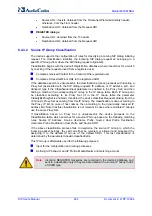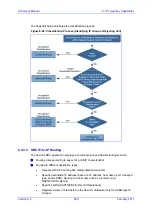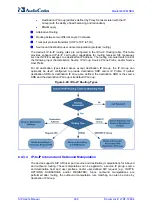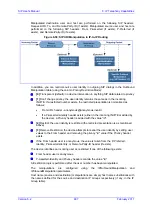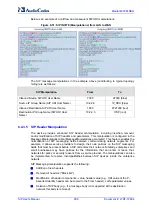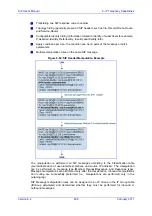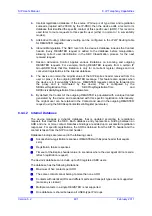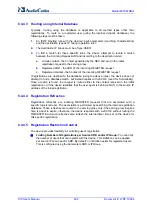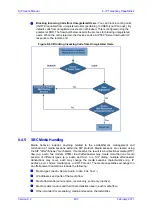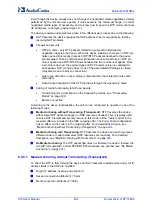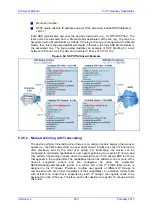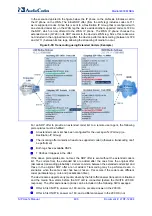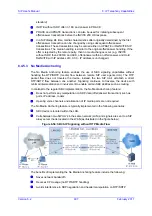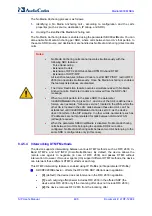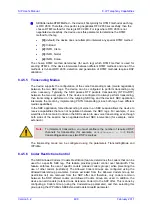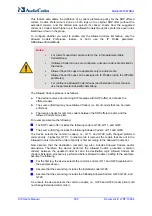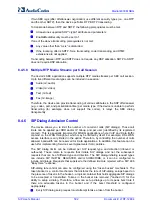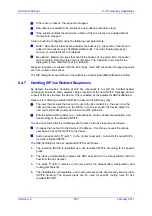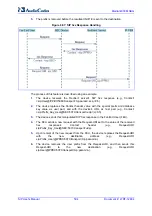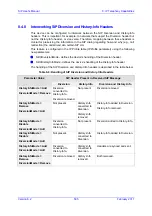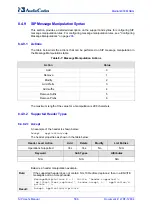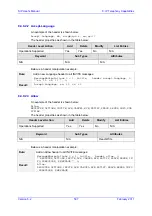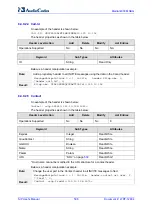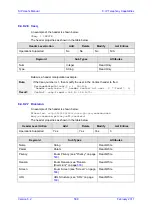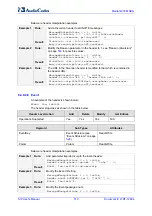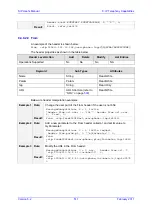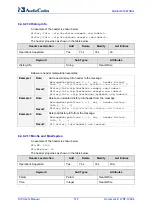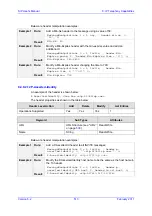
SIP User's Manual
498
Document #: LTRT-12804
Mediant 800 MSBG
The No Media Anchoring process is as follows:
1.
Identifying a No Media Anchoring call - according to configuration and the call’s
properties (such as source, destination, IP Group, and SRD).
2.
Handing the identified No Media Anchoring call.
The No Media Anchoring feature is enabled using the parameter SBCDirectMedia. You can
also enable No Media Anchoring per SRD, where calls between two UA's that pertain to
the same SRD (source and destination) are handled as No Media Anchoring (direct media)
calls.
Notes:
•
No Media Anchoring calls cannot operate simultaneously with the
following SBC features:
- Force transcoding
- Extension Coders
- Extension of RFC 2833/Out-of-band DTMF/In-band DTMF
- Extension of SRTP/RTP
All restriction features (Allowed Coders, restrict SRTP/SRT, restrict RFC
2833) can operate simultaneously. Once No Media Anchoring is enabled,
the features listed above are disabled.
•
The Coder Restriction feature operates simultaneously with No Media
Anchoring calls. Restricted coders are removed from the SDP offer
message.
•
When two UA's pertain to the same SRD, the parameter
IntraSRDMediaAnchoring is set to 1, and one of the UA's is defined as a
foreign user (example, “follow me service”) located in the WAN, while the
other UA is located in the LAN: calls between these two UA's can’t be
established until IntraSRDMediaAnchoring is set to 0, as the device
doesn’t interfere in the SIP signaling. In other words, parameters such as
IP addresses are not manipulated for calls between LAN and WAN
(although required).
•
When the parameter SBCDirectMedia is disabled, No Media Anchoring
calls between two UA's belonging to separate SRD’s cannot be
configured. No Media Anchoring calls between two UA's belonging to the
same SRD is configurable only (in this case).
8.4.5.4 Interworking DTMF Methods
The device supports interworking between various DTMF methods such as RFC 2833, In-
Band DTMF’s, and SIP INFO (Cisco\Nortel\Korea). By default, the device allows the
remote user agents to negotiate (in case of RFC 2833) and passes DTMF without
intervention. However, if two user agents (UA) support different DTMF methods, the device
can interwork these different DTMF methods at each leg.
This DTMF interworking feature is enabled using IP Profiles (
ini
file parameter IPProfile):
SBCRFC2833Behavior - affects the RFC 2833 SDP offer\answer negotiation:
•
[0]
(default): the device does not intervene in the RFC 2833 negotiation.
•
[1]:
each outgoing offer\answer includes RFC 2833 in the offered SDP (the
device adds RFC 2833 only if the incoming offer does not include RFC 2833).
•
[2]:
the device removes RFC 2833 from the incoming offer.
Содержание Mediant 800 MSBG
Страница 2: ......
Страница 366: ...SIP User s Manual 366 Document LTRT 12804 Mediant 800 MSBG Reader s Notes ...
Страница 372: ...SIP User s Manual 372 Document LTRT 12804 Mediant 800 MSBG Reader s Notes ...
Страница 390: ...SIP User s Manual 390 Document LTRT 12804 Mediant 800 MSBG Reader s Notes ...
Страница 404: ...SIP User s Manual 404 Document LTRT 12804 Mediant 800 MSBG Reader s Notes ...
Страница 616: ...SIP User s Manual 616 Document LTRT 12804 Mediant 800 MSBG Reader s Notes ...
Страница 636: ...SIP User s Manual 636 Document LTRT 12804 Mediant 800 MSBG Reader s Notes ...
Страница 652: ...SIP User s Manual 652 Document LTRT 12804 Mediant 800 MSBG Reader s Notes ...
Страница 886: ...SIP User s Manual 886 Document LTRT 12804 Mediant 800 MSBG Reader s Notes ...
Страница 890: ...User s Manual Ver 6 2 www audiocodes com ...

